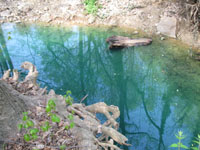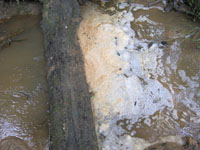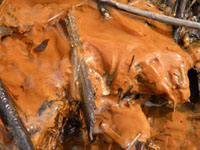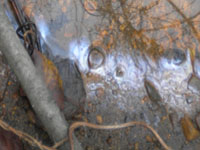What's in the creeks?
Creeks and streams around the City may not always look the way we expect. Sometimes, stream water may take on unusual colors or textures that alarm us and we may see things in streams that we do not recognize. This page will help you identify a few reasons behind the colors and foam we observe in the creeks and streams.
CRYSTAL BLUE
 A crystal blue color in the water may indicate a non-toxic pond dye or algaecide used to improve lake and pond appearances that has washed downstream. Neither is toxic to humans or wildlife.
A crystal blue color in the water may indicate a non-toxic pond dye or algaecide used to improve lake and pond appearances that has washed downstream. Neither is toxic to humans or wildlife.
DARK BROWN OR BLACK
 Murky brown or black water in still areas of a stream can be caused by the tannins released by the decomposition of organic material. While the tannins cause the darker pigment, they are part of a natural process and non-toxic.
Murky brown or black water in still areas of a stream can be caused by the tannins released by the decomposition of organic material. While the tannins cause the darker pigment, they are part of a natural process and non-toxic.
ORANGE SLIME
 A slimy orange substance can indicate a type of bacteria. It takes in iron from the groundwater, which oxidizes as it is turned into energy. Oxidation prevents iron from dissolving into the water, and can produce the orange color. It can also take the form of an oily sheen. Oxidizing bacteria is not harmful, and may accumulate for several months until it is washed away.
A slimy orange substance can indicate a type of bacteria. It takes in iron from the groundwater, which oxidizes as it is turned into energy. Oxidation prevents iron from dissolving into the water, and can produce the orange color. It can also take the form of an oily sheen. Oxidizing bacteria is not harmful, and may accumulate for several months until it is washed away.
OILY SHEEN
 An oily sheen doesn’t necessarily indicate petroleum. If the sheen can be broken up with a stick and stays apart, it is likely bacteria similar to the orange slime. However, if the broken sheen recombines into a whole, it may be a petroleum spill. If you believe a petroleum spill has occurred, please call 301-891-7633.
An oily sheen doesn’t necessarily indicate petroleum. If the sheen can be broken up with a stick and stays apart, it is likely bacteria similar to the orange slime. However, if the broken sheen recombines into a whole, it may be a petroleum spill. If you believe a petroleum spill has occurred, please call 301-891-7633.
FOAMY AND BUBBLY WATER
 Foam, suds, and bubbles might indicate either a natural process or human pollution. Natural bubbles can be from the decomposition of plant and algae growth, and often increase after rainstorms.
Foam, suds, and bubbles might indicate either a natural process or human pollution. Natural bubbles can be from the decomposition of plant and algae growth, and often increase after rainstorms.
Fertilizer from lawns can be carried by rainwater into Takoma Park’s streams, while detergents from washing dishes, cars, and clothes can all be sources of foam into the water. However, many detergents are biodegradable and their foam will dissipate on its own. If a foul odor is present, it could be a leaking sewer line.
HOW TO TELL THE DIFFERENCE BETWEEN NATURAL AND MAN-MADE FOAM
Natural sources from decomposition of leaves, twigs or other organic substances:
- Natural foam appears as light tan or brown, but may be white and has an “earthy,” “fishy” or “fresh cut grass” odor.
- Natural foam occurs at many locations along a stream, accumulating on or near the bank, or on other material in the stream.
- Natural foam can be seen in eddies or floating downstream.
Natural foam increases after rain storms as rainfall transports the decomposed plants to the stream. - Natural foam can cover large areas and can accumulate in large amounts.
Man-made sources include yard fertilizing, car washing, washing machine discharge, sanitary sewer or septic field failures:
- Foam from man-made sources is usually white and fragrant or perfumed.
- Foam from man-made sources will accumulate near the source of the discharge.
- Foam from most detergents is biodegradable and will disappear quickly.
- Foam from leaking sanitary sewer lines or septic fields will have a foul odor.
- Foam from man-made sources is likely not related to rain storms.
If you see foam, suds or bubbles in a stream that you suspect is a result of a sanitary sewer line break, or if you detect the odor of sewer gas, call the Takoma Park Public Works at 301-891-7621
The information on this page was used with permission from the Fairfax County Department of Public Works and Environmental Services, Stormwater Management (https://www.fairfaxcounty.gov/publicworks/stormwater/whats-stuff-stream)
